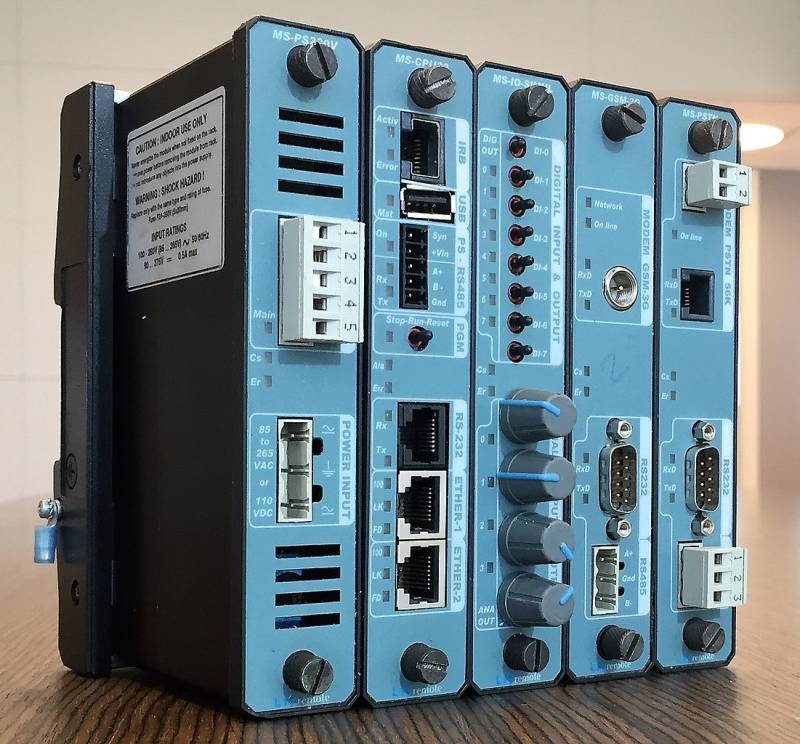The Value of Integrating Remote Terminal Units in SCADA Systems

Remote Terminal Unit Modular. Photo: FernaCM / Wikipedia.
Supervisory Control and Data Acquisition (SCADA) systems are the cornerstone of industrial automation, underpinning the efficient and centralized monitoring of operations spread over large areas.
Integral to these systems are remote terminal units (RTUs). These intelligent electronic devices function as the field interface, meticulously gathering data from different sensors.
They then seamlessly transmit this data to the central SCADA master station, forming the backbone of real-time situational awareness.
Additionally, the remote terminal unit can receive control commands, enabling it to manage equipment and influence industrial processes remotely.
The seamless integration of RTUs is important for ensuring the smooth operation and effective administration of a SCADA system.
The Role of RTUs
An RTU essentially bridges the gap between the physical world and the SCADA system. Located at remote sites, they connect to various field devices like pressure gauges, temperature sensors, flowmeters, and control elements like valves and pumps.
Here's a breakdown of their core functionalities:
- Data Acquisition: Remote terminal units gather real-time data from connected sensors. This data can be analogue (continuous signals) or digital (on/off states). The remote terminal unit processes and formats this data for transmission to the central SCADA system.
- Communication: Remote terminal units utilise various communication protocols to transmit data to the master station. Common options include wired connections like Ethernet or serial lines or wireless technologies like cellular networks or satellite communication. The chosen method depends on factors like distance, reliability requirements, and infrastructure availability.
- Control Functions: Beyond data acquisition, some RTUs offer limited control capabilities. They can receive commands from the SCADA system and activate connected equipment based on pre-programmed logic or operator instructions. This allows for remote actuation of valves, pumps, or other control elements.
- Alarming and Event Management: RTUs can be configured to monitor sensor readings against pre-defined thresholds. If a parameter exceeds or falls below the designated limit, the remote terminal unit can trigger alarms within the SCADA system, notifying operators of potential issues.
How to Integrate RTUs for Optimal Performance
Integrating remote terminal units effectively requires careful planning and configuration. Here are some key considerations:
- RTU Selection: Selecting the right remote terminal unit depends on the specific application. Factors to consider include the number and type of field devices to be connected and the required communication protocols. Additionally, consider the control functionalities needed and the environmental conditions at the remote site.
- Communication Infrastructure: A reliable communication infrastructure is crucial for ensuring seamless data flow. Evaluate wired and wireless options based on cost, terrain, and network availability. Redundancy measures might be necessary for critical applications.
- Configuration and Programming: Each remote terminal unit needs to be configured to communicate with the SCADA system and process data from connected sensors. This may involve setting communication parameters, defining data acquisition routines, and programming control logic if applicable.
- Security Measures: Remote terminal units form a critical link in the SCADA system, so robust security measures are essential. Implement access controls and secure communication protocols, and consider network segmentation to minimize vulnerabilities to cyberattacks.
Benefits of Partnering with Reputable Energy Brands to Integrate RTUs
Integrating RTUs and managing a SCADA system can be a complex task. Partnering with a reputable energy brand with expertise in automation and control systems can offer significant benefits. These companies have experience working with various remote terminal unit models and SCADA systems, providing guidance on equipment selection.
Reputable energy brands ensure proper integration and offer ongoing support. They also provide training on remote terminal unit configuration, SCADA system management, and compliance with strict regulations regarding data security and system operations.
Leading energy brands can offer advanced solutions like pre-configured RTUs, cloud-based SCADA systems, and remote monitoring services, enhancing system performance, improving data accessibility, and simplifying management.
By effectively integrating RTUs and collaborating with a reputable energy brand, you can ensure smooth operation and optimal performance. This will translate to improved process efficiency, enhanced data-driven decision-making, and a more reliable and cost-effective operation.




















